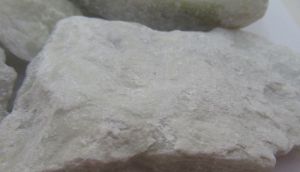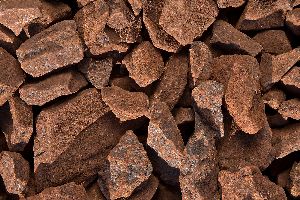
Talc
Properties & uses Talc is a soft, nonabrasive, inert mineral that can be ground easily (flaky habit) to form white and bright (>78 GE) fine to micronized powder that acts as a functional filler (paint; plastics; paper; rubber; adhesives; joint compounds; stucco; pharmaceuticals). Additional advantages include its high oil and grease absorption capabilities (organophilic/hydrophobic) [cosmetics and pharmaceuticals; pitch-control in pulp; paper filler and coater; dusting and mold-release agent; bitumen filler] and its flaky habit provides structural strength, pigmentation, opacity, rheology, viscosity, and corrosion and weathering resistance [paint; specialty plastics; various rubber compounds] In Paint, talc has a reinforcing effect, controls viscosity, prevents sagging of paint films, improves suspension characteristics, and because of its large surface area (>12 m2/g) dictates gloss. In Plastics, talc has a strong reinforcing effect. In Pharmaceuticals and cosmetics talc’s greasy feel [lubricant or glident], fragrance retention [talcum powder, soaps, creams, and lotions] and hiding powder are useful characteristics. In roofing products, talc acts as a stabilizer for the melted asphalt thus increasing resistance to fire and weathering. In ceramics, talc’s high fusion point (heat-stable up to 900°C), fluxing action (due to MgO), and predictive thermal expansion allow lower firing temperatures and shorter firing cycles to be achieved. Steatite is a massive, cryptocrystalline form of Talc which can be machined easily, has uniform low shrinkage in all directions, and high electrical resistivity when fired [electronic insulators]. Soapstone is a massive green to gray to a black mixture of talc and magnesite that is aesthetically pleasing and can be cut with a knife or machined, resists weathering and acid and alkali attack, is non-toxic and non-absorbent, retains heat, has a melting point of 1630°C and can be polished. Grades we offer We offer different grades of Talc catering Paint, Rubber, Ceramic, PVC, master batchers industries. For further details on grades available and offers please contact us. Quality and Specifications Ceramic grade: min 30% MgO and 60% SiO2 Cosmetic grade: max 0.1% water soluble substances, 6% acid-soluble substances, 6% LOI @ 1000°C. Paint grade: min 88% Mg & Ca Silicate, Max CaO, 1% water-soluble matter, 1% moisture and other volatiles, 7% LOI @ 1000°C
...more
SILICA AND QUARTZ
SILICA & QUARTZ Silica is the principle glass-forming oxide making up approximately 60% of soda-lime-silica glass batch. Silica sand/quartz is heat resistant to approx. 1470°C and is used as a foundry sand in the manufacture of molds and cores for casting metals. Properties & uses Silica is relatively inexpensive, hard (H7), inert & resilient, with conchoidal facture [abrasive; filtration media; engine sand; construction sand & gravel] with certain grades having a round-shaped grain used as a proppant or fracturing sand to prop open fissures and void in bedrock and so improve permeability [oil well drilling & production]. These attributes plus whiteness, low oil absorption, and grindability to specific particle sizes allow silica sand flour to be used a filler [paint; plastics; rubber; adhesives; putty; caulks; and sealants]. Grades we offer We offer Quartz lumps and Quartz grits for engineering stones industry. For further details on grades available and offers please contact us. Quality & Specifications Ceramic grade: (-200 Mesh) > 97.5% SiO2,
...more
Red Hematite Stone
Properties & uses Hematite is commonly used in primer paint since its high density, fairly large particle size, and low oil absorption allow heavy loading; in addition, it provides some protection against corrosion [industrial maintenance finishes for railroad equipment, bridge paints, etc.] Finely ground Hematite is used because of its abrasiveness [jeweler’s rouge; ophthalmic polishing] and its high SG [weighting agent in drilling muds; high-density aggregates]. Grades we offer We offer API grade for the oil drilling industry. For further details on grades available and offers please contact us. Quality & specifications API: SG > 5 and -200 Mesh
Material : Iron Oxide
Color : Red
Feature : Durable, Fine Finished
Packaging Type : Plastic Bags
...more
Feldspar
FELDSPAR Feldspar are aluminosilicates with varying amounts of K, Na and Ca in a solid solution series; the main commercial feldspars lie between the sodium(albite) and potash (Microcline) rich end members, and the sodium end of the sodium-calcium series (Oligoclase). Properties & uses In glassmaking feldspar is used a source of Al2O3, Na2O, and/or K2), and SiO2 [borosilicate glass; soda-lime glass; fiberglass; TV tube glass]. The alumina enhances the workability of molten glass, increases the resistance of glass to chemical corrosion, improves the hardness and durability, and inhibits devitrification, In ceramics, feldspar acts as a flux to form a glassy phase in bodies [vitreous and semi vitreous china; wall & floor tile; sanitary ware; electrical porcelain; frits, glazes & enamels]. Feldspar is also used as a mild abrasive [scouring powders] and welding rod coating; With properties such as sub-angular particle shape, H 6-6.5, G.E. brightness 0f 82-92%, non-photo reactivity, and low free silica content, fine-ground feldspar is a useful filler. Grades we offer We offer grades of sodium and potassium bases feldspar for the ceramic industry. For further details on grades available and offers please contact us. Quality & specifications: Soda spar is preferred in glass and potash spar in ceramics. Glass grade feldspar: 4-6% K2O, 5-7% Na2O, 19% Al2O3 with a max 0.08% Fe2O3. Pottery grade feldspar: 5-14% K2O, with max 0.07% Fe2O3.
...more
Barite
Properties & Uses Barite is a clean, relatively soft, virtually inert, and quite inexpensive mineral with high Specific gravity (hence used as weighing agent in drilling mud). Drilling muds account for more than 90% of the worldwide market for Barite. The properties noted for drilling muds plus its light color and high brightness (up to 90+%), low oil absorption, and wettability by oils allow Barite to be used as a filler and weighing agent. [acoustical compounds; adhesives, athletic goods (bowling balls, golf balls, tennis balls); carpet backing; friction materials; linoleum; mold release agents; paints including primer (automotive and appliance) top coats(automotive), gloss enamels, powder coatings, semi-gloss and gloss latexes, and industrial and architectural coatings; paper; radiation shielding; rope finishes; rubber; urethane foams. Barite is used as a source of BaO in glass making where it acts as a flux oxidizer, and decolorizer giving greater brilliance and clarity to the finished glass. The high SG is used in the construction industry to weigh down underwater pipelines. Barite absorbs gamma radiation and can replace lead in nuclear shields. High – purity Barite is a feedstock for the chemical industry. Grades we offer We offer different grades of Barites catering to Oil Drilling and Paint Industries. For further details on grades available and offers please contact us. Quality & Specifications API drilling mud grade barite: 4.2 SG min; 250 ppm Ca max., 95% -45µm (350 Mesh) Paint filler-grade barite: min. 95% BaSO4 ; max 0.05% Fe2O3
...moreBe first to Rate
Rate ThisOpening Hours